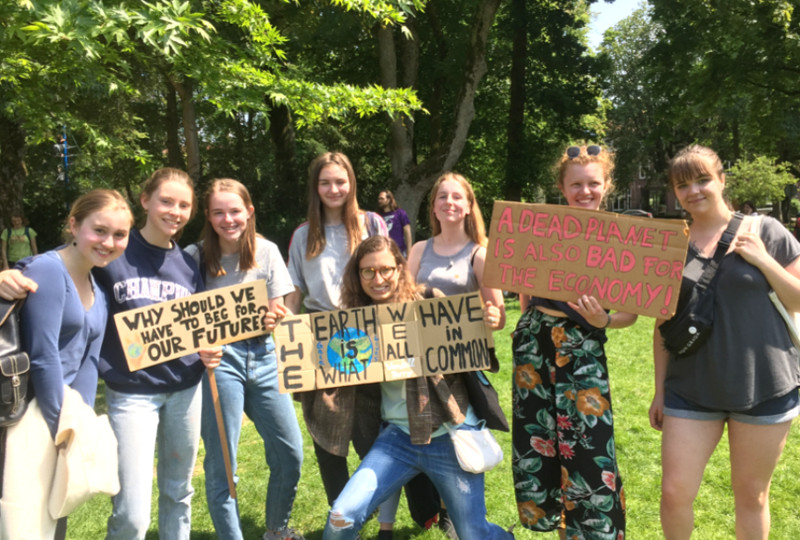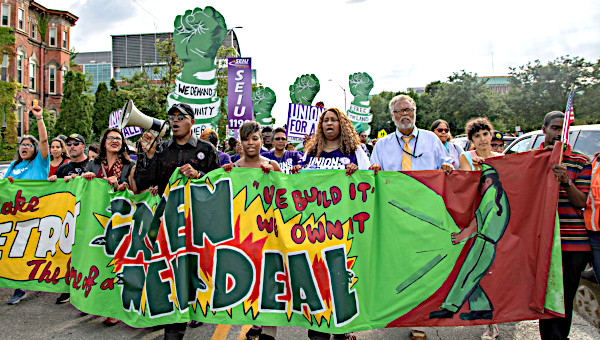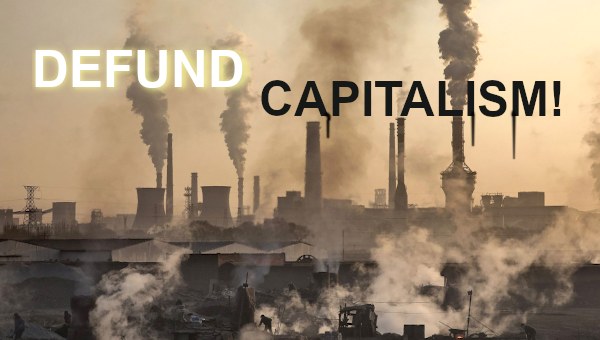What Will it Take to Win a Green New Deal?
The push for a Green New Deal (GND) that’s become a big topic of political discussion in the US has come north. At the beginning of May 2019, the Pact for a Green New Deal was launched publicly in Canada. It was endorsed by a range of organizations and prominent individuals. Behind the scenes, staff from a number of major NGOs including Greenpeace and Leadnow are playing key roles in the initiative.
 The Pact calls the GND “a vision of rapid, inclusive and far-reaching transition, to slash emissions, protect critical biodiversity, meet the demands of the multiple crises we face, and create over a million jobs in the process. It would involve the full implementation of the United Nations Declaration on the Rights of Indigenous Peoples (UNDRIP) including the right to Free, Prior and Informed Consent (FPIC), dozens of other pieces of legislation, new programs and institutions, and a huge mobilization calling on the creativity and participation of all of us.”
The Pact calls the GND “a vision of rapid, inclusive and far-reaching transition, to slash emissions, protect critical biodiversity, meet the demands of the multiple crises we face, and create over a million jobs in the process. It would involve the full implementation of the United Nations Declaration on the Rights of Indigenous Peoples (UNDRIP) including the right to Free, Prior and Informed Consent (FPIC), dozens of other pieces of legislation, new programs and institutions, and a huge mobilization calling on the creativity and participation of all of us.”
The Pact sets out “two fundamental principles” for a GND: “1. It must meet the demands of Indigenous Knowledge and science and cut Canada’s emissions in half in 11 years while protecting cultural and biological diversity”, and “2. It must leave no one behind and build a better present and future for all of us.”
The Strategic Importance of a Green New Deal Campaign
Over 100 town hall meetings have been held in cities, towns and smaller communities to discuss what should be in a GND, and more are planned. The results of the discussions are supposed to be reported back and used to develop a package of GND policies. It seems that the contents of the package will eventually be decided by some of the people, mostly NGO staff, doing the work of the Pact for a GND Coalition. The Coalition, however, will not be campaigning publicly between June 30th and the federal election due to election advertising regulations. The GND policy package will be launched after the federal election, with the Coalition talking internally about doing some kind of mass mobilization around it.
It does matter what the specific GND policies will be – but not only or mainly for the reason that some anti-capitalists think. Some radicals in the US have dismissively criticized the GND championed by Alexandria Ocasio-Cortez and other Democratic politicians for not targeting the capitalist system itself. In a much more constructive reflection, British socialist Richard Seymour has asked if the GND depends “on magical thinking about technology and capitalism? Are the legislative tools it looks to adequate? Is it internationalist, or can it be? Does it risk further commodifying the natural world?” Seymour suggests “we need the GND plus something else.”
We definitely need accurate assessments of the enormous scale of change needed to carry out a just transition away from a way of organizing society that spews out vast quantities of greenhouse gases. As Samuel Miller McDonald argues, “we first have to be clear-eyed about the challenges involved.”
But the key issue with a GND is not whether its demands, if they were implemented, would provide a full and complete just solution to the climate crisis (or to every other injustice that needs uprooting). Thinking about it that way assumes that a GND must contain everything we’re ultimately fighting for.
It’s more useful to think about a GND in the way McDonald suggests: “what a Green New Deal must do is begin to establish the political and cultural conditions in which this scale of transition becomes possible.” As US socialist Thea Riofrancos puts it (quoting left critic of the GND Jasper Bernes): “‘shifting the discussion, gathering political will, and underscoring the urgency of the climate crisis.’ If, through the vehicle of the amorphous Green New Deal, left forces might achieve these three tasks, that strikes me as an exceedingly important development; not an end in and of itself, of course, but it’s unclear to me how a pathway to radical transformation wouldn’t pass through these three crucial tests of political capacity.”
Put simply, what matters most about a GND is that it can serve as a tool that people can use to start to build a larger and more powerful movement for climate justice. What we need is many more people in motion. Another document that, like the Leap Manifesto of 2015, gets some people talking and influences left politics but doesn’t lead to mass action won’t cut it.
More important than the details of what’s in a GND is what people will do to try to win it. If we’re serious about a GND, don’t we owe it to ourselves to do some hard thinking about what’s the best way to fight for it?
The Green New Deal and the Federal Election
All that the Pact for a Green New Deal website says is “we’ll bring our shared vision for a Green New Deal to political leaders, and challenge them to adopt these visionary policies in their platforms.” This is a sorry excuse for a strategy. The federal NDP leadership already showed how it treats anti-neoliberal climate justice politics when it responded to supporters of the Leap Manifesto with a convention resolution referring the document to riding associations for discussion in 2016. This succeeded in killing the push to have the party adopt the manifesto. It’s unclear what key NGOs involved in the Pact for a GND Coalition imagine a mobilization after the federal election would look like, but they definitely don’t have a track record of building escalating mass actions on a pan-Canadian level.
A clearer strategy for winning a GND has been proposed by 350.org’s new Our Time campaign. Our Time aims to mobilize young people “to vote for Green New Deal champions and against politicians in the pocket of Big Oil” in the federal election this fall and then “be ready after the election with a mass movement.”
Our Time’s call to vote against Big Oil’s servants sounds suspiciously like a signal to vote for the candidate best-placed to prevent a Conservative win if there’s no GND champion to vote for. That would mean voting Liberal in many ridings. But the Liberals are a neoliberal ruling-class party too. We’ve seen the Liberals’ response to the climate change emergency: build the Trans Mountain Pipeline, deploy the RCMP against indigenous land defenders, and bring in a carbon tax that will do little or nothing to reduce emissions.
Who will the GND champions be? Presumably candidates who endorse Our Time’s version of a GND. If any Liberals endorse it, they shouldn’t be believed. So what about NDP candidates?
The federal NDP leadership doesn’t support freezing fossil fuel expansion, massive government spending on energy and public transportation, a job guarantee for workers whose jobs are eliminated, and other basic GND reforms. Its new “Power to Change: A New Deal for Climate Action and Good Jobs” responds to pressure from climate justice activists and fear of losing votes to the Green Party with a couple of steps in the right direction. These include the goal of slashing GHG emissions to meet the target for 2030 that the UN Intergovernmental Panel on Climate Change says is needed for Canada to make its contribution to giving the world a good chance of preventing global temperatures from rising more than 1.5°C. But the NDP policy doesn’t include the measures needed to actually achieve this goal, which would include nationalizing the fossil fuel industries.
Still, some NDP candidates will endorse a GND. But what will those of them elected as MPs do? Will they defy caucus discipline and introduce a private member’s bill to draw more attention to the GND after the next election, even if the top brass of the party is against them doing it? A GND bill would be helpful to climate justice campaigners. It wouldn’t pass in the House of Commons but it could attract a lot of attention and change more people’s expectations about what’s possible and necessary. However, a caucus rebellion is unlikely if there isn’t a growing climate justice movement pushing NDP MPs who say they support a GND to introduce a GND bill even if doing so risks them getting kicked out of the NDP caucus.
Building the Fight for a Green New Deal
This takes us back to the really important question: how best to fight for a GND? Here it’s worth repeating the best line in Naomi Klein’s book This Changes Everything: Capitalism vs. the Climate: “Only mass social movements can save us now.” No one has a recipe for generating those movements, least of all me. But we should start by getting clear about what’s needed and start discussing how pushing for a GND could help give birth to it.
History gives us no reason to believe that NDP or Green Party leaders will just change their minds, support a package of reforms that meet the criteria set down in the Pact for a GND, win a federal election, and then deliver on their promises in spite of intense opposition from capitalists. It’s also a mistake to focus on getting people to vote in the federal election, with the idea of having a movement ready for after the election – that puts the cart before the horse.
Instead, GND supporters should set our course in the direction of a social movement larger and more powerful than any in Canadian history. Such a movement can’t be summoned into being in the short term by the frantic work of organizers. Sustained upsurges of collective action by large numbers of people aren’t built like that – they happen, when they do. But organizing today really does matter. As Jane McAlevey argues, “there is one key strategy that has a track record of actually winning the hardest fights in our history… organizing. Real organizing.”
There’s a lot of potential for organizing on a larger scale than we’ve seen so far. Thousands of really young people have been taking part in the Friday climate strikes inspired by Greta Thunberg. Many of them are determined to work for transformative change and are quickly gaining a radical understanding of the roots of the climate crisis. Many people have mobilized in recent years against pipelines or attacks by right-wing provincial governments. Many more people sense the scale of the climate crisis and are open to getting involved in a push for a response that appears to rise to the challenge in a way that also takes aim at social inequality and injustice.
Without large-scale organizing, a truly mass movement will never erupt in the future. Organizing for a GND can be a key ingredient for the movement we need. So too can efforts on other fronts, including anti-pipeline campaigns, resistance to austerity, and anti-colonial struggles.
 This year we can use the federal election campaign as an opportunity to popularize the GND as an urgently-needed response to the climate crisis, and to get more people involved in climate justice organizing. But let’s remember that what matters most is building a movement, not electing some NDP MPs pledged to a GND. Actions by young people and adults as part of the September 27 #Strike4Climate called by Thunberg and her fellow student climate strike organizers provide a chance to get more people involved.
This year we can use the federal election campaign as an opportunity to popularize the GND as an urgently-needed response to the climate crisis, and to get more people involved in climate justice organizing. But let’s remember that what matters most is building a movement, not electing some NDP MPs pledged to a GND. Actions by young people and adults as part of the September 27 #Strike4Climate called by Thunberg and her fellow student climate strike organizers provide a chance to get more people involved.
It would take a mighty movement acting in the midst of a political crisis to drive a government to adopt a GND. It’s quite likely that the ecological crisis along with capitalist restructuring could cause a political crisis in the future. Governments responding to flooding, droughts, wildfires, storms and other problems in ways designed above all to keep profits flowing, probably accompanied with deeper austerity for public services like healthcare and education, could well spark a crisis. In that context, a movement demanding a GND and organizing huge protests, occupations and strikes would have a fighting chance.
We’ll need a really powerful movement because we’re not just up against the fossil fuel companies. The banks and other large corporations with significant investments in fossil fuels will also oppose any GND worthy of the name. So too will other capitalists who hate the idea of FPIC, massive public sector spending that doesn’t boost their profits, and a government job guarantee for anyone whose job is lost in a transition to renewable energy. In other words, supporters of a GND are up against the Canadian capitalist class (although some sectors are more hostile than others). We also have to contend with political parties that enthusiastically defend or, in the case of the NDP, accept the system that has us on a path to catastrophic climate change: capitalism.
I’ll give the last word to Riofrancos: “The opposite of pessimism isn’t self-assured optimism, but rather militant commitment to collective action in the face of uncertainty and danger.” •
This article first published on the New Socialist website.





